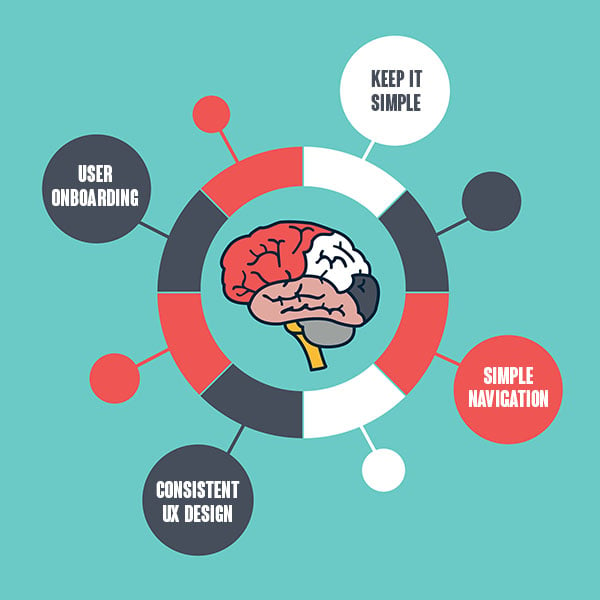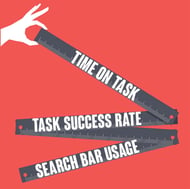![What is learnability in UX design? Simplicity, Consistency, Teaching [graphic] A brain connects to a lightbulb and to the letters S, C, T.](https://www.thecreativemomentum.com/hs-fs/hubfs/blog-files/2009%20batch/2009-05-LearnabilityUX-image-h(1).jpg?width=600&name=2009-05-LearnabilityUX-image-h(1).jpg)
Learnability is how quickly a person can learn to use something. It can be a TV remote, a new blender, a piece of software, or even a website.
People tend to gravitate toward items that are easy to learn, and they avoid difficult, frustrating processes. Make it easy on them, and increase the learnability of your website by using proper UX design.
Why You Should Use Learnability in Your Website’s Design
Learnability is closely related to usability. The faster visitors can learn the layout and navigation of your website, the easier it is for them to use it. As any good web designer knows, usability is key when it comes to web design.
Think about software with steep learning curves like Microsoft Excel and Photoshop. They’re both extremely helpful, but you have to know how to use them first. Many people get frustrated by the learning curve and give up. That’s why having Microsoft Excel on your resume looks so good! If people don’t find your website usable, they’ll probably leave and not come back. According to online studies, 80% of online shoppers say they wouldn’t return to a site after one bad user experience.
By diminishing your site’s learning curve — increasing learnability — you make it easier for visitors to use it. People don’t like to put in effort. The internet is all about easy solutions! So, when people can learn to use your site without much effort, they’re more likely to stick around and make it farther down your marketing funnel.
4 Ways to Improve Learnability in Your UX Design
 If you want visitors to use your website and accomplish their goals, the site must be easy to learn. Here are a few UX design tips to boost your website’s learnability.
If you want visitors to use your website and accomplish their goals, the site must be easy to learn. Here are a few UX design tips to boost your website’s learnability.
1. Keep It Simple
Sensory overload can happen. When you give website visitors too much to look at, they can become confused. Without a clear starting point, users may become frustrated.
Eliminate clutter, keep your website clean, and guide users toward the next step. The simpler the interface—and the fewer options to choose from—the faster people will learn how to use your site.
2. Use Consistent UX Design Elements
While swapping fonts and changing icons might be fun and creative, it can also confuse your users. People have good memories. They start to expect certain elements when they visit websites and use applications.
For example, if you see a different-colored phrase in a block of text, you probably assume it’s a link. If you use common elements found throughout the internet, users will have a head start when it comes to learning your website.
You should also keep your internal UX design choices consistent. If you use a specific icon to indicate the shopping cart, keep that icon throughout. Even if it’s still a picture of a shopping cart but in a different style, it could be enough to throw off some users.
By keeping design elements consistent, when users learn how to navigate one page of your website, they’ll be able to navigate them all.
3. User Onboarding
For more complex websites, it might be helpful to provide user onboarding. User onboarding teaches new users how to use your site before they actually dive into the specific elements. In your onboarding guide, you should answer two questions:
- Why should users invest their time learning?
- What can your website help them accomplish?
Usually, website onboarding comes in the form of a friendly slideshow or pop-up bubble that appears the first time users visit your site. Give them a simple task and walk them through it. Once finished, they’ll feel eager to learn more.
4. Simple Navigation
Your navigation can make or break your website. When someone visits your site, they’re not interested in taking the time to learn; they’re on a mission. They want to accomplish the task they set out to achieve. If they visit your website and aren’t sure how to accomplish their task, they’re going to be frustrated.
Tricky navigation menus regularly top the list of web page design mistakes to avoid. They make the entire user experience complicated and turn users off. Keep it simple, limit the information to only the essentials, and make that information easy to find.
How to Measure Website Learnability
 Once you implement UX design elements to increase website learnability, how do you know they’re working? When it comes to web design and digital marketing, it’s all about the data. Here are three key performance indicators (KPIs) that you can use to measure learnability.
Once you implement UX design elements to increase website learnability, how do you know they’re working? When it comes to web design and digital marketing, it’s all about the data. Here are three key performance indicators (KPIs) that you can use to measure learnability.
1. Time on Task
How long does it take a user to accomplish a task? If it takes too long, the process might be too complicated.
This KPI can be tricky because every task is different. One task on your website might be short and simple while another takes much longer. Base your metrics on how long it takes users to accomplish tasks.
Once you come up with your time standards, measure them against the users’ times and see how it evolves over time. Are your users getting faster as time goes on? How steep is the learning curve?
2. Task Success Rate
You want to know how long it takes people to accomplish each task, and you also want to know if they accomplish them at all. If you notice high bounce rates and abandoned shopping carts, it could indicate that your website is too hard to use and that users are giving up mid-task.
Take the number of users who finished a task and divide it by the total number of users. This will give you your “task success rate.” While you want to get as close to 100% as possible, most websites barely break 50%, so don’t feel bad if you don’t get perfect scores. Keep coming up with ways to boost learnability and raise your score as high as it can go.
3. Search Bar Usage
Unless it’s a massive website with countless categories like Amazon or Wikipedia, most website visitors prefer navigation menus over search bars. But, if they find the navigation menus confusing, they head to the search bar as a backup.
If your search bar is getting more love than your navigation menu, it’s a good indicator that your website learnability needs some work.
Increase Learnability for a Better UX
Learnability and usability go hand in hand. You want your website to be easy to use so visitors come back time and time again to purchase your products and hire your services. If your website is complicated and hard to learn, users will run to competitors with simpler sites.
Make it easy for visitors to use your website. They’ll be more likely to come back.

